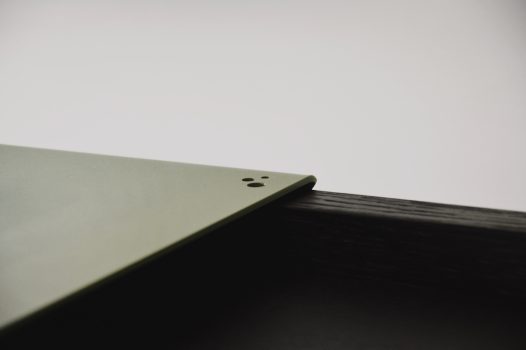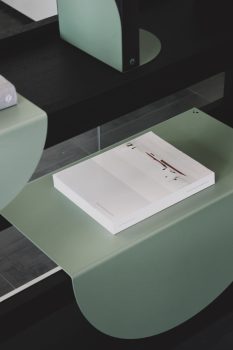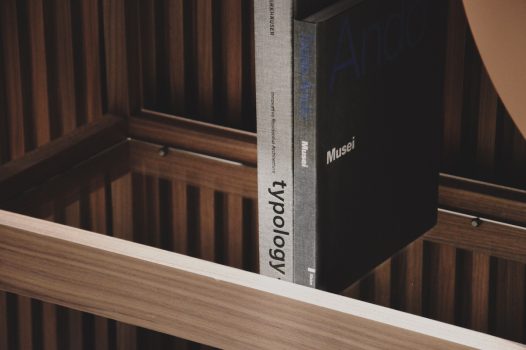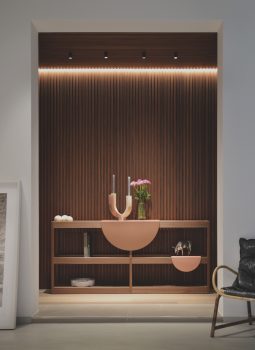MEET THE DESIGNER: GIANMARCO MIOLO TALKS ABOUT THE BUBBLE PROJECT
Gianmarco Miolo tells us about the inspiration, creative process and details of the BUBBLE modular bookcase project.
INSPIRATION AND CONCEPT
What was the inspiration behind the modular bookcase you designed and what were the main objectives you wanted to achieve with this project?
Behind the design of each of my design objects there is the search for union between my two worlds: architecture and design.
The origins of “Bubble” recall a building that arises from a solid, regular and modular structure, like a set of beams and pillars that form the basis for a skyscraper on which a facade is applied, a box that is personalized by what is inside and what shines through on the outside, capable of relating to the world of design for its functionality at a smaller scale like that of an interior.
The intent of “Bubble” is to create an unconventional bookcase, which can be positioned on the wall, but which can also function as a sculptural fulcrum within a room, as a work of art admirable from multiple points of view, which manages, through equal and standardized elements, to have a unique soul, or rather, a multiplicity of souls belonging to those that compose it, which through the personalization and free positioning of the trays manages to forge a strong bond with the composer, capable of changing over time.
I compare the bookcase to the notes of a piano which, through the musician, give shape to the artistic composition.

CREATIVE PROCESS
Can you describe your creative process in conceiving and designing the modular bookcase?
My creative process is a continuous succession of phases that are not always linear, but start from a certain point: pencil in hand. I believe that the romanticism of hand drawing, of a sketch on a napkin or any sheet of paper, is the strongest form of connection between intuitions, visions or inspirations and the realization of the design object or architecture.
Quick drawings, repeated several times, refining some details each time, different perspectives, sometimes even wrong, make me feel alive and constitute a cloud of lines on which to then obtain the drawing to be refined, through three-dimensional modulation, a fundamental phase for bringing to concrete ideas.
The main difficulty of a path that leads to the production of a design object is mainly that of keeping the initial idea unchanged when tackling the prototyping and engineering phase of the product.
The fundamental key was the comparison with Xilia which, while following production rules and dynamics, through the sharing of common objectives, the trust shown in me and their experience, led to a product of the highest quality.
FUNCTIONALITY AND VERSALITY
What are the key features of the modular library in terms of functionality and versatility?
How did you balance aesthetics with practicality in the design?
One of the founding principles of the “Bubble” library is the strong flexibility, which allows, in addition to a unique and never the same aesthetic, through the sliding of the trays on the wooden structure, to adapt to the objects it can contain.
Glass shelves and sliding trays can be removed or moved if necessary, allowing, for example, the positioning of plants or objects that can develop in height for two or more modules, such as a double or triple height of a building. This dynamism declares and underlines how aesthetics and functionality are inextricably united, giving uniqueness and concreteness to the product.

MATERIALS AND SUSTAINABILITY
Have you considered sustainability in the choice of materials or in the production process?
Sustainability for “Bubble” is not simply a word that enriches the project, but rather, it is a conscious and concrete choice .
Only 3 materials were used such as wood, glass and steel, all completely 100% recyclable. Respect for the environment is fundamental in every single choice today which will translate into a long-term response. In “Bubble”, together with Xilia, it was in the choice of both the bookcase materials and the packaging themselves, with a view to recycling and reuse for true and lasting sustainability.
USER INTERACTION
Have you integrated user experience elements into the design?
The bookcase is not simply a container object, but in “Bubble” it transforms into a tool that allows users to express their creativity and personality through the positioning of the trays, variations in their colors and the insertion of objects that dialogue with the bookcase, merging into a work of One of a kind art.
The bookcase is not the protagonist, on the contrary, it is at the service of the true protagonist who is the end user, who through playful dynamism can have an object that symbolizes his own personality.
ADAPTABILITY TO THE ENVIRONMENT
How does the modular bookcase adapt or integrate with different types of environments or furnishing styles?
“Bubble” adapts completely to any style or type of environment. I have always thought of it as a sort of sculpture, an object that can be seen from different angles, but its delicacy and elegance allows it to adapt to any environment, space or type of use, such as in an architectural studio with its models or rolls of boards, in a personal library with books that seem to float on the glass shelves, in the middle of a living room in a historic building from large heights to a minimal kitchen as a wine rack.
No constraints, adaptable and dynamic in its entirety.

PRODUCTION AND ASSEMBLY
How did you address manufacturing and assembly considerations when designing the modular bookcase?
The issue of mass production and reproducibility of a design object is fundamental for the full success of the project and for its economic sustainability.
Thanks to Xilia and their experience, a great job has been done in these terms and the result is a product that can be easily assembled, even by the end user, thanks to the Installation through joints and without the use of glues or chemical materials.
DESIGN TRENDS
How did you take current trends in industrial design into account when designing the modular bookcase?
I honestly tried to develop a product as if I were the end user and introduced the features that I would like to have when choosing a very high quality bookcase, without thinking too much about the range of bookshops on the market.
The customization of the elements of the library, the dynamism and change that it can undergo over time, I believe, are winning elements for a unique product, which makes the user experience a creative experience, makes him participate in an artistic act like a painter in front of a blank canvas, in a market already full of standardized objects.
The trays with their colors wink at current trends, offering some colours, let’s call them “pop”, but they certainly do not undermine the concreteness of the project with its strong identity, its exclusivity, its dynamism, its flexibility and undisputed functionality.
PERSONAL IMPACT
Is there any design element that you consider distinctive of your signature as an industrial designer?
For me, the bookcase constitutes a sort of new push towards the world of design, a goal that does not have the flavor of victory, but of a new start, that mix of emotions between the happiness of seeing one of my ideas transformed into reality, gratitude towards Xilia who he believed in me and did everything possible and impossible to keep my concept faithful to the end and desire to continue designing and designing objects that can last over time.
I don’t know if there are distinctive elements of my signature but I know that characteristics such as the elegance and simplicity of the lines are what I would like to convey with my projects.

